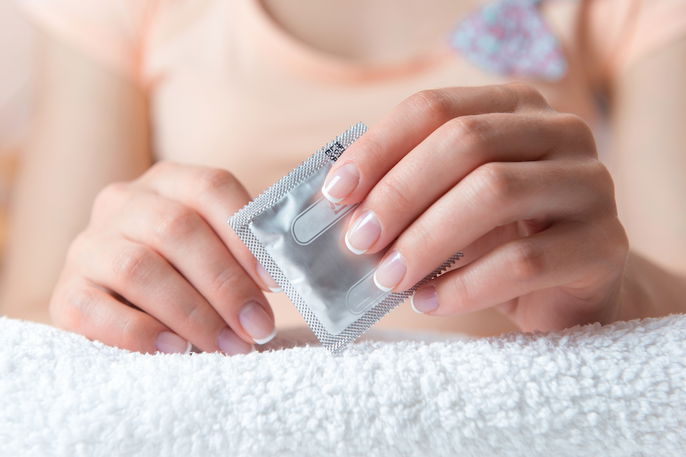It is possible to get pregnant using a condom, however it is extremely rare. A risk for pregnancy increases if there are errors made when using them, such as not removing the air from the tip of the condom, not checking the expiry date of the product or opening the package using sharp objects that puncturing the condom material.
Condoms, both male and female, prevent sperm from coming into contact with the vaginal canal. When used correctly, they are up to 98% effective in preventing pregnancy, as well as preventing sexually transmitted infections (STIs).
Therefore, to avoid pregnancy, you should put on and take off condoms as directed, or combine its use with other contraceptive methods, such as contraceptive pills, like an IUD or the vaginal ring. Learn more about other birth control options you can use with a condom.

Common mistakes with condoms
The most common mistakes made when using condoms that can increase the chances of pregnancy are:
- Using an expired or old product
- Using a condom that has been stored in your wallet for a long time, as excessive heat can damage the material
- Not having enough lubrication, which can dry out the material and rip the condom
- Using petroleum-based lubricants instead of water, which damage the material
- Opening the package with your teeth or other sharp objects
- Unrolling the condom before putting it on the penis
- Removing and reusing the same condom
- Putting on a condom after unprotected penetration
- Not removing the air that accumulates in the tip
- Using the wrong size condom
- Removing the penis from the vagina after it has decreased in size, as this increases the risk of sperm leaking through the condom and coming into contact with the vagina.
To ensure correct use, you should open the condom packaging with your hands, fitting the ring of the condom over the head of the penis, and holding the tip with your fingers to prevent air from accumulating.
Then unroll the condom to the base of the penis with the other hand, checking at the end to see if there is any air left in the tip where the semen will collect.
Types of condoms
Condoms vary according to length and thickness. Some have additional characteristics such as taste, presence of spermicide and lubricant.
It's important to pay attention when buying condoms so that the right size is used, as condoms that are too loose or too tight can slip off the penis or break, increasing the risk for pregnancy or STIs.
1. Basic
This is the most commonly used and easiest to find, and is made of latex and with water-based or silicone lubricants.
2. Flavored
These are condoms with different flavors and aromas, such as strawberry, grape, mint and chocolate, and are mainly used during oral sex.
3. Female condom
These are thinner and larger than male condoms and should be placed inside the vagina, with their ring protecting the entire outer region of the vulva. See how to use ARTICLE NOT FOUND IN EN: here.
4. With spermicidal gel
In addition to the lubricant, a gel is also added to the material that kills sperm, further decreasing the risk for preventing pregnancy.
5. Latex free or anti-allergic
As some people are allergic to latex, there are latex-free condoms available on the market. These are made of polyurethane, which prevents allergic reactions, pain and discomfort caused by conventional material.
6. Extra thin
These are thinner than conventional condoms and fit tighter on the penis. They are used to facilitate sensitivity during sex.
7. With numbing gel
In addition to the lubricant, a gel is added to the material which reduces the sensitivity of the penis, prolonging the time it takes for the man to reach orgasm and ejaculate. This type of condom may be suitable for men with premature ejaculation, for example.
8. Hot and Ice
These are made with substances that heat up and cool down according to the movements, increasing the sensation of pleasure for both men and women.
9. Textured
Made with material that has ribbing or different textures, these condoms increase pleasure for both men and women, as they increase sensitivity and stimulation.
10. Glow in the dark
They are made with phosphorescent material, which glows in the dark and encourages the couple to explore other games and intimacy during sex.
Diseases that condoms protect against
In addition to preventing unwanted pregnancies, condoms also prevent infection with sexually transmitted diseases such as AIDS, syphilis and gonorrhea.
However, if a partner presents with skin lesions are present before sex, the condom may not be enough to prevent contamination, as condoms do not always cover all the sores caused by the disease, It is important to complete full treatment of an STI before having sex and using a condom.






























